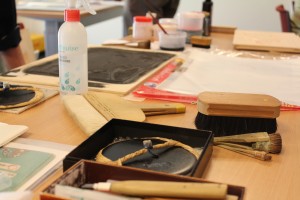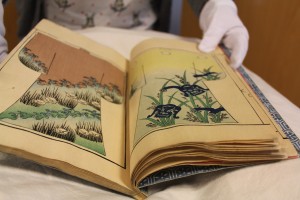
Beginning on the woodblock and ending in the wardrobe – this is the journey a group of oriental enthusiasts were taken on last Wednesday afternoon. And, just like the artistic wave of Japonisme that charged its way through the Western world during the 19th century, the imaginations of those gathered at the State Library were filled with historical footsteps of the most aesthetically elegant kind.
We arrived with only basic knowledge and departed with what was guaranteed to be a “hopeless addiction” to two of Japan’s most delicate art forms. With a woodblock print demonstration and verbal voyage through the traditional Japanese wardrobe promised, the crowd assembled eagerly, many already dressed to impress in Asian-inspired attire.
Condensing what sometimes takes months to complete into a thirty-minute display, Terry McKenna from the Australian Mokuhanga School opened the afternoon with a crash course in woodblock printing. Somewhat overlooked as a form of fine art in its traditional territory, to many Japanese artisans this rigorous method of carving, smoothing, rolling and pressing ink from block to paper is considered little more than a commercial process.
“The artists come up with these unique prints, only to be forgotten behind the demand of the publisher in the printing room,” McKenna explained, “it was always a collaborative project, and the craftsman remained largely anonymous.”
But similar to the Kimono, during the mid 1800s when Japan exited trade isolation and reopened its ports to the global market, Mokuhanga prints became sought after artefacts, regarded as exotic and luxurious by even the most astute of European art collectors.
Similarly, just as Mokuhanga inspired the imaginations of artists like Edgar Degas and Vincent van Gogh, the mysterious Kimono was adopted and interpreted by the Parisian fashion crowd, injecting a hit of cultural confusion into previously conservative couture houses and design ateliers.
But as Leanne O’Sullivan from Melbourne’s Kimono House was quick to demonstrate, the Kimono’s translation from local to international stage came with a change of context and meaning. Carefully unwrapping her multi-layered mannequins, O’Sullivan explained the significance and function behind every knick and knack, proving that despite the basic ‘wrap-like’ design of the contemporary Kimono, the garment – which actually encompasses a number of occasional, seasonal and hierarchical variations, is one complicated outfit choice.
Fittingly referred to as “a world of undergarments,” O’Sullivan’s demonstration proved the Kimono makes stressing over contemporary lingerie choices seem rather trivial. At once, a Samurai might be wearing up to twelve layers of Kimono, all pressed into place by numerous belts and sashes and a collection of rolled towels, “to fill in the gaps.”
Learning about a culture that has made such an artistic and aesthetic impression on our own is something truly special. And, concluding the seminar with an intimate viewing of some of the Library’s rare Japanese artist books from the Edo Period, Off the Page, Onto the Kimono proved to be one of these especially enlightening experiences.
If you missed out, don’t fret – the Libraries Edo-era collection is still on display. The decorated doors to O’Sullivan’s Swanston Street Kimono House are always open, and if you think you’d like to try your hand at some Mokuhanga, McKenna will welcome you into his class with open arms and a sturdy block of wood.



